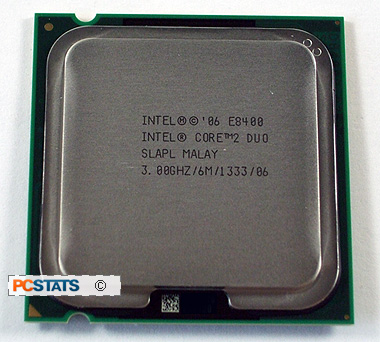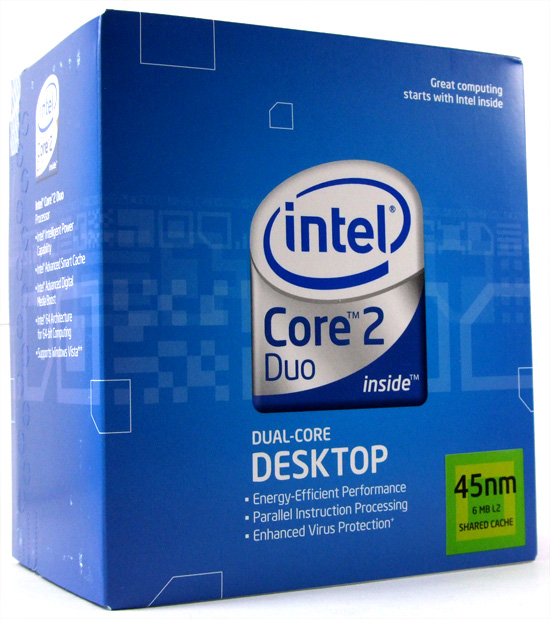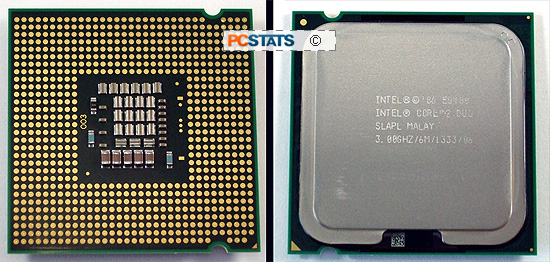Let's take a step back in time to when CPUs
were easy to understand. Comparing different processors used to easy, the
higher the clock speed of the chip, the faster it was. That's all
there was to it, 3GHz was better than 2.4GHz, and that's all one needed to know. The numbers game has
of course been relegated to a historical footnote by newer core technologies that re-wrote the rules - anyone
remember the shock of a Core 2 Duo processor out pacing a Pentium 4 chip at
twice the speed?
Moving from single core to dual-core processors had
an immediate benefit in many computing situations; background applications could run on one core, while the other focused on the
tasks at hand. Moving from two cores to four cores hasn't been quite the universal panacea
for processing power. Only a few applications make effective use of all that
parallel processing goodness....
Which brings us to the Intel
Core 2 Duo E8400, a 3.0GHz dual-core processor based on the 'Wolfdale' core
that is being manufactured on the 45nm process. This socket 775 processor packs in 6MB
of L2 cache and operates with a 1333MHz Front Side Bus speed. The
Intel Core 2 Duo E8400 retails for around $199
CDN ($170 USD, £113 GBP),
which makes it considerably more affordable than quad-core processors with equivalent clock
speeds and cache.
So how does the E8400 compete against
the new quad-core chips from AMD and Intel? While more cores can make a
big difference in multi-threaded applications, they can also trip over
themselves and slow down single-threaded applications. For everyday
computer users, a fast dual-core CPU might be all the processing
power you really need, let's find out!
 |
|
|
Intel Core 2 Duo E8400 Processor |
|
|
 |
| Tech
Specs |
|
Core 2 Duo E8400
Clock:
3.0 GHz
Codename: Wolfdale
Cores: 2
L1: 2 x
64K
L2: 6MB
Multiplier: 9x
FSB
Bus: 1333 MHz
Package: LGA775
Socket: 775
organic
mPGA
Core: 45nm
Transistor: 400M
Power: 65
Watts
Vcore: 0.850-1.3625V
Cost: $203 CDN
|

| |
Intel's Core 2 Duo E8400 processor is physically similar
to the Core 2 Duo E6750 (Conroe) and Socket 775 Pentium D
processors that came before it. All of these processors use the Land Grid Array 775-pad package. Intel's move to
a 45 nanometer manufacturing process means the silicon die here is approximately
104mm2 in area and contains around 410 million transistors. While the Core 2 Duo E8400 is
a Socket 775 CPU, it isn't compatible with all Socket 775 motherboards, due to
different voltage requirements and processor power envelopes.
Currently the Intel X48, X38, P45, P35, G35, G33 and G31 chipsets have native support for 45nm 'Wolfdale'
processors and will support the 1333MHz Front Side Bus speed. Motherboards with
older chipsets may support Wolfdale processors like the E8400 processor though
BIOS updates, although compatibility isn't universal. As always, check the
vendor's support page before you pick up any new parts.

Due to its 45nm die-shrink, the Intel Core 2 Duo E8400 processor can be clocked
at higher speeds yet maintain the same thermal design power (TDP)
as the older 65nm E6000 series of processors. The typical TDP for the Core
2 Duo E8400 processor is 65W.
1333 MHz Front Side Bus Speed
/ 45nm Wolfdale Core
Wolfdale processors are currently Intel's fastest dual-core processors. You can
identify a Wolfdale processor by its family series. The Intel E5000, E7000
and E8000-series are all based on the Wolfdale core, and share the same 45nm
manufacturing process.

The Intel Core 2 Duo E8400 is a member
of the highest end family. All E8000-series processors have 410 million
transistors, 6MB of L2 cache, run at a 1333MHz front side bus, and have a TDP of
65W. The lower end of the Wolfdale dual-core processor families scale down
accordingly: the E7XXX family of processors have 3MB of cache and run at a
1066MHz FSB, and the Intel E5XXX family, which has 2MB of cache and runs at
800MHz FSB.
| Intel Socket 775 'Wolfdale' 45nm Processors |
|
Processor Models |
Thermal Design
Power |
Clock
Speed |
FSB |
L2 Cache
Size |
Price
(USD) |
| Intel Core 2 Duo E8600 |
65W |
3.33 GHz |
1333MHz |
6MB |
$266 |
| Intel Core 2 Duo E8500 |
65W |
3.16 GHz |
1333MHz |
6MB |
$183 |
 Intel Core 2 Duo E8400 Intel Core 2 Duo E8400 |
65W |
3.0 GHz |
1333MHz |
6MB |
$163 |
| Intel Core 2 Duo E8300 |
65W |
2.83
GHz |
1333MHz |
6MB |
$163 |
| Intel Core 2 Duo E8200 |
65W |
2.66
GHz |
1333MHz |
6MB |
$163 |
| Intel Core 2 Duo E8190 |
65W |
2.66
GHz |
1333MHz |
6MB |
$163 |
| Intel Core 2 Duo E7500 |
65W |
2.93
GHz |
1066MHz |
3MB |
$133 |
| Intel Core 2 Duo E7400 |
65W |
2.8
GHz |
1066MHz |
3MB |
$113 |
| Intel Core 2 Duo E7300 |
65W |
2.66
GHz |
1066MHz |
3MB |
$133 |
| Intel Core 2 Duo E7200 |
65W |
2.53 GHz |
1066MHz |
3MB |
$113 |
Intel has also added some new instruction sets for its Wolfdale (dual-core)
and Yorkfield (quad-core) 45nm processors. The new SSE4 (Supplemental Streaming
SIMD Extension, if you were wondering) instructions consist of 47 new vector
instructions, most of which focus on improving the processor's co-ordination
with graphics and video acceleration.
Hardware virtualization has also improved, better for applications
like VMware. Intel's improved hardware assisted virtualization is better at
managing requests from the virtual manager, which allows both the virtual
machine and the native operating system to make calls to the hardware without
conflicting with one another. The larger, 6MB cache on the high-end
Wolfdale processors is also very useful in these environments.
Intel's also talked a lot about how power efficient these new 45nm Wolfdale
processors are going to be - so of course PCSTATS is going to put their claims to
the test...

